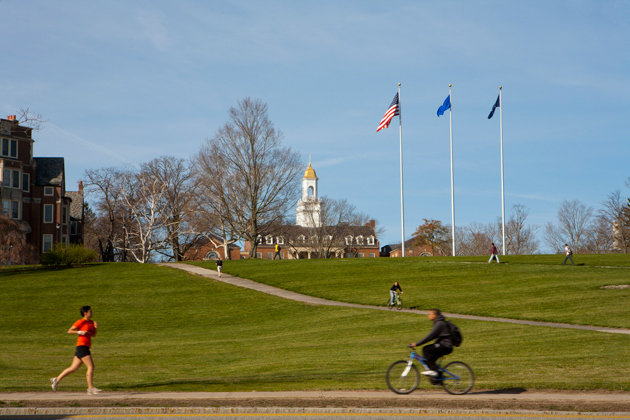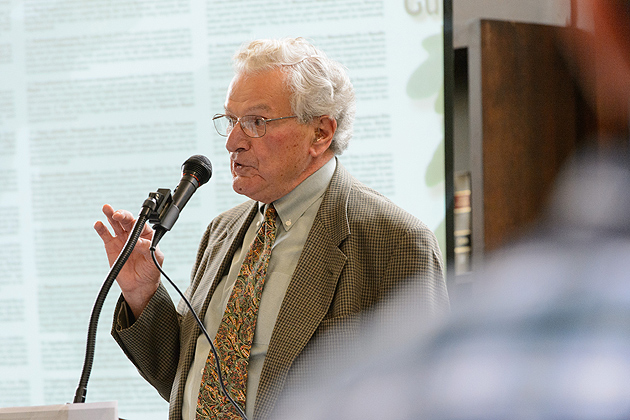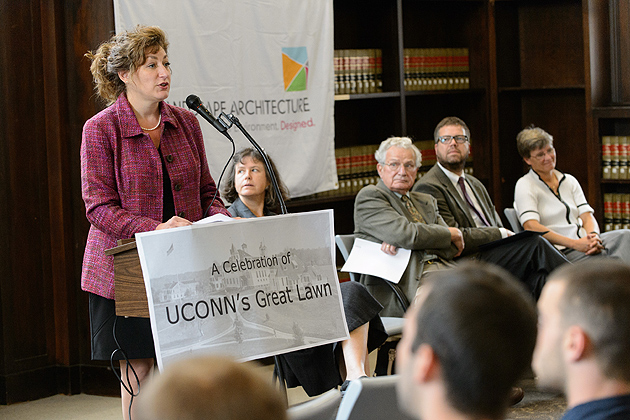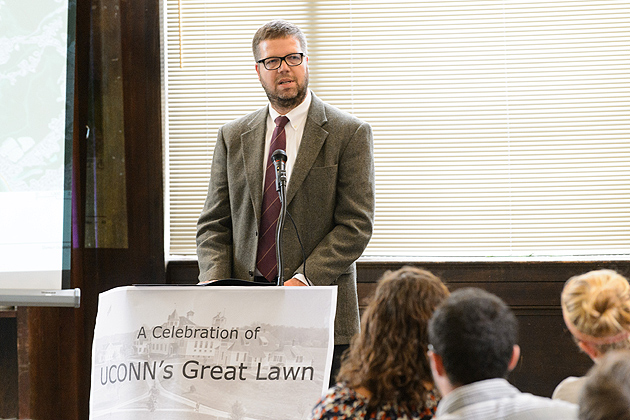
The University of Connecticut’s iconic ‘Great Lawn’ was the center of attention on Wednesday at a celebratory event sponsored by the UConn Student Chapter and the Connecticut Chapter of the American Society of Landscape Architects.
And although it might at first seem unusual to celebrate green space on a campus that is dotted by brick and mortar architectural landmarks that bear the names of University leaders dating from the 1800s to the present, a keynote address by professor emeritus Rudy Favretti quickly established the importance of the lawn as UConn’s ‘signature’ landmark.
Favretti, a fellow in the American Society of Landscape Architects, taught in the College of Agriculture and Natural Resources from 1955 to 1989 and established the department of landscape architecture. He gave an historical overview explaining how the various parcels of land that comprise the 50-acre lawn were acquired, and how that space came to be listed on the National Register of Historic Places.

“The Great Lawn as we know it was started with a series of four different hay fields belonging to four different families. The piece given by the Storrs brothers to provide land for the Storrs Agricultural School was a small portion of what we now know as the Great Lawn,” said Favretti.
“This was in the middle of the great American park movement, and when Charles L. Beach became President [1908-1928], he took a great interest in the land. He worked with noted landscape architect Charles Nassau Lowrie as they created the foundation for the lawn as we know it.
“While they [Beach and Lowrie] were deciding how the lawn would integrate and connect the campus on both sides of Storrs Road and into what is now the central part of campus, Professor Albert Gulley [for whom Gulley Hall is named] developed an arboretum on the northern part of the lawn. The trees at that part of the lawn were part of Gulley’s original plan and they were planted in such a way on the perimeter of the lawn that they define the space much like the English landscapes we have studied throughout the years, with a few specimen plants scattered throughout as sculptural features.”
But, Favretti added, the Great Lawn has never been a static or formal place. He mentioned the various activities that have taken place in this space over the years, including everything from outdoor classes to sledding, ice skating on Mirror and Swan Lakes, touch football, and various demonstrations and gatherings. Included in the latter, he said with a twinkle in his eye, “We used to elect the ‘Mayor of Storrs,’ and students would run for the office using made up names … some a little bawdy … and they would deliver spirited campaign speeches on the lawn as they ran for this fictitious office.”
The beautiful landscape of UConn is an incredibly important part of our tradition. It is not just symbolic; it is the heart of who we are as an institution.

President Susan Herbst, who was introduced by student ASLA president Andrea Fossa ’13 (CLAS), said that one of the great things about the University is that it is forever.
“It will outlive all of us,” she said. “We hold onto traditions and achievements that are rooted in our beginnings, and the beautiful landscape of UConn is an incredibly important part of our tradition. It is not just symbolic; it is the heart of who we are as an institution.”
She continued, “… our success is not just measured in charts and graphs, but by the physical state of our campus. Every lawn, every tree, flower bed, shrub, and walkway tells us a lot about ourselves. It’s the first thing and the last thing that our visitors see. We must always improve and enliven our historic landscape.”

Mark Westa, associate professor of landscape architecture in the College of Agriculture and Natural Resources, concluded the ceremony, which had been moved inside to the North Reading Room of Wilbur Cross due to an ominous weather forecast, with the news that three new trees are being added to the landscape of the Great Lawn.
The University,” he said, “is a place of individual growth and the pursuit of knowledge, but beyond that, a great university requires a great sense of community … a community that shares an identity and a history and a sense of hope.”
Three Dakota Pinnacle Japanese White Birch trees are being planted on the Great Lawn, Westa announced, “as tangible symbols of rededication that are central to our community,” as outlined in the University’s 2010 Landscape Master Plan.



